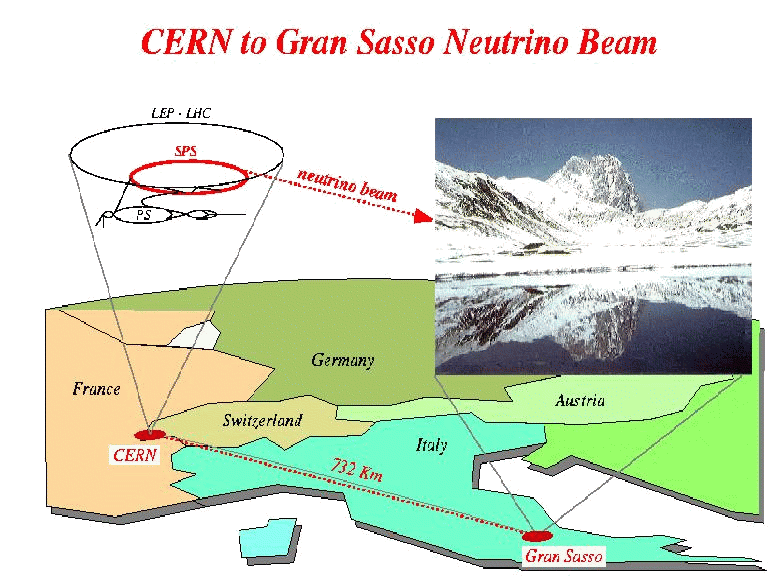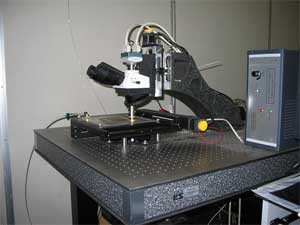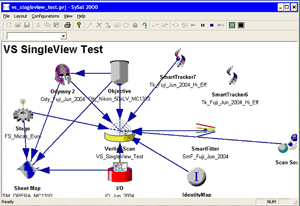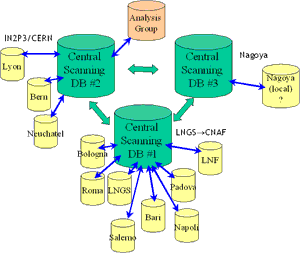 Several
Italian and European physicists are involved in the OPERA experiment,
trying to detect the appearance of ντ in a pure beam
of νμ. The CNGS beam, almost purely made of muon neutrinos,
is produced at CERN towards the Laboratori Nazionali del Gran Sasso. During
their travelling length (732 km) some muon neutrinos are expected to "transform"
into tau neutrinos (neutrino oscillation). The OPERA detector, using lead
as a target and nuclear emulsions as tracking devices, is expected to
signal tau neutrino appearance.
Several
Italian and European physicists are involved in the OPERA experiment,
trying to detect the appearance of ντ in a pure beam
of νμ. The CNGS beam, almost purely made of muon neutrinos,
is produced at CERN towards the Laboratori Nazionali del Gran Sasso. During
their travelling length (732 km) some muon neutrinos are expected to "transform"
into tau neutrinos (neutrino oscillation). The OPERA detector, using lead
as a target and nuclear emulsions as tracking devices, is expected to
signal tau neutrino appearance.
It is the first time worldwide, and in particular in High Energy Physics,
that nuclear emulsion are used on such a large scale.
Right:
sketch of the CNGS beam line from CERN to Gran Sasso
OPERA
is optimized to show the signal in the oscillation parameter region pointed
at by the SuperKamiokande experiment. Cristiano Bozza is among the first
proposers of OPERA to the SPSC. The OPERA discovery potential is extremely
high, è estremamente elevato, thanks to the very low physical and
instrumental background achieved through nuclear emulsions. In the SuperK
favoured oscillation parameter region, OPERA is almost certain to observe
oscillation signal; if not so, a vast oscillation parameter region would
be excluded.
Right:
probability to observe tau neutrinos, and exclusion plot in case of no
appearance detection
 Cristiano
Bozza is the European Contactperson for the data-taking software of the
European Scanning System (ESS), used in the OPERA
experiment by all European labs to take data from nuclear emulsions.
Cristiano
Bozza is the European Contactperson for the data-taking software of the
European Scanning System (ESS), used in the OPERA
experiment by all European labs to take data from nuclear emulsions.
The ESS (European Scanning System) uses high technology commercial components
to set the world record in scanning speed on nuclear emulsions at 20 cm2/h/side
with angular acceptance for microtracks up to tanθ=1.
The camera is a Mikrotron MC1310 with 1280x1024 pixel resolution in a
8-bit greyscale, operated at 376 fps (frames per second), with a data
flux as large as 471 MB/s.
The mechanics have been developed by Micos in joint work with the European
Emulsion Group, of which the Salerno Emulsion Group is part, and reaches
a precision of 0.1 μm.
The optics has been developed byNikon in joint
work with the European Emulsion Group, of which the Salerno Emulsion Group
is part,
and provides corrected images on a field of view as large as 400 μm.
The motion controller is a National Instruments FlexMotion PCI 7344 card.
The image preprocessor, mainly used for 2D filtering, is a Matrox Odyssey
XCL Pro.
The control workstation is a Dell Precision 650.
Right: one of the automatic microscopes running the ESS in the laboratory of the Salerno Emulsion Group
 SySal,
the ESS software, is mainly developed in Salerno by the Salerno Emulsion
Group.
SySal,
the ESS software, is mainly developed in Salerno by the Salerno Emulsion
Group.
It is a flexible imaging system, developed with the commitment to be hardware-independent,
and designed to adapt to very diverse real working conditions, able to
work 24 hours per day without human assistance.
The system has been programmed mostly in C++ for the parts that directly
interact with the microscope (although critical code sections have been
written in Assembler), with an extensive use of COM/ActiveX. High level
code (strategy control, decisions, etc.) have been written in C# using
the .NET framework.
The software recognizes 3D microtracks in both thin and thick emulsion
layers in realtime and with sustained flux.
Right: SySal snapshot
 Cristiano
Bozza is the Main Developer for the "OPERA Scanning Database"
(the database that hosts OPERA emulsion data) and leads the development
and management team, which involves scientists from several countries.
Cristiano
Bozza is the Main Developer for the "OPERA Scanning Database"
(the database that hosts OPERA emulsion data) and leads the development
and management team, which involves scientists from several countries.
TheOPERA Scanning DB is a unique example in High Energy Physics
of fully relational DB without external file data
sources. Real implementations of this DB can accept data
at a rate between 30 and 60 MIph (Million INSERTs per hour), and the final
size of the data set at the end of OPERA is foreseen to be between 30
and 100 TB.
The DB has an automatic data replication structure that makes data worldwide
data sharing efficient while ensuring redundancy and data safety.
Right: data sharing schema among the various local sites
 Cristiano
Bozza has been measuring and analyzing interactions in nuclear emulsions
from pion, muon and neutrino beams.
Cristiano
Bozza has been measuring and analyzing interactions in nuclear emulsions
from pion, muon and neutrino beams.
Several steps are needed for such activities:
- data taking by the automatic microscope;
- microtracks linking between either emulsion sides;
- alignment and connection of tracks from originally stacked plates;
- volume track reconstruction;
- vertex reconstruction;
- momentum/energy estimation and particle identification for event tracks;
- kinematical reconstruction events;
- physical
interpretation.

